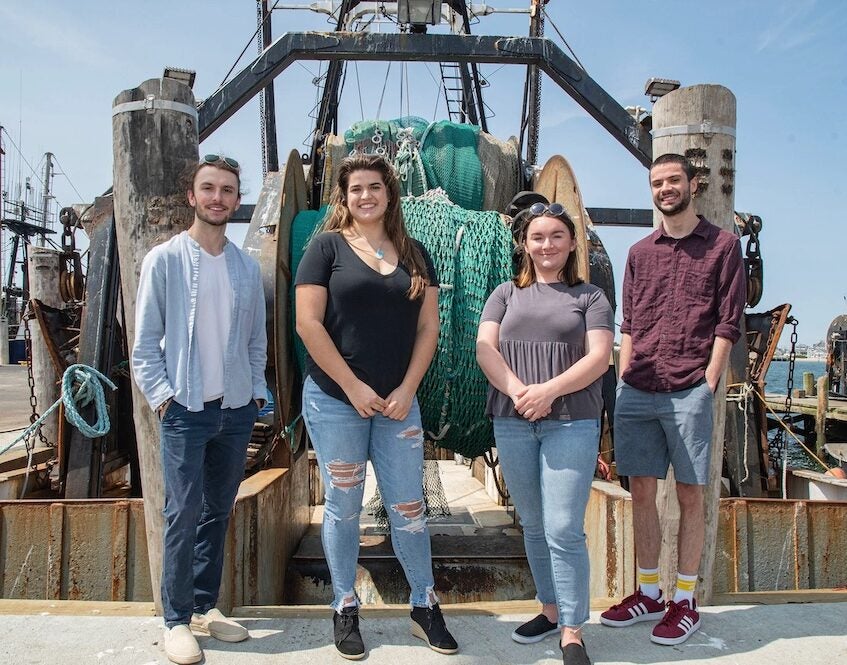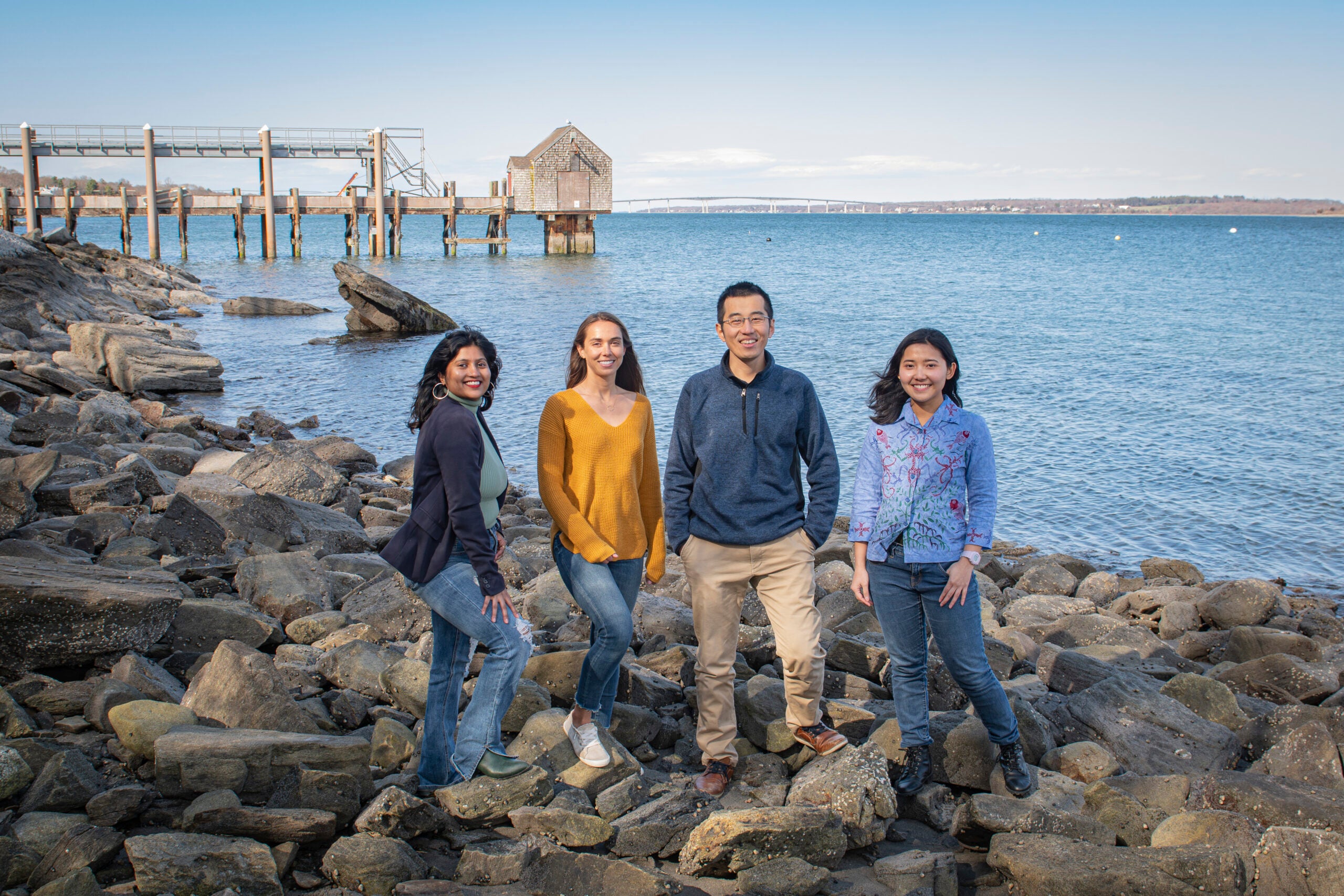Sign up for Hacking4Oceans, and you’re looking for a problem.
July 5, 2023
A big problem. A wicked-in-the-scientific-sense-of-the-word problem. Something beyond the scope of government. Something quite possibly impossible to solve.
This past spring, MBA students Michael Cascione and Michael Molinski and undergraduates Sydney Johnston ’24, an ocean engineering major, and Kaitlyn Fucillo ’25, marine biology and ocean engineering, worked on finding a solution for abandoned, lost, or discarded fishing gear left in the ocean. The interdisciplinary Hacking4Oceans course requires students to examine a critical and complex problem facing our oceans and then propose a solution. The multidisciplinary course requires student scientists to think like entrepreneurs and activists.
A bit about the scale of the problem: ghost gear refers to unclaimed recreational and commercial nets, buoys, lobster traps, crab and shrimp pots, line, and rope left in ocean water—debris that, if combined, weighs about as much as 640,000 Mitsubishi Mirages. Imagine that: 640,000 Mistubishi Mirages driven into the ocean and left there every year. That is, if you take the conservative annual ghost gear estimate, some people put the amount of ghost gear entering the ocean yearly at 800,000-1.2 million tons.
‘Good faith, bad consequences’
But there’s more: in Rhode Island, it’s illegal to remove ghost gear from the ocean for almost everyone except for the state’s Department of Environmental Management. If you do, you’re fined. And the thing is, ghost gear continues to work; that is, it still traps marine life. Some experts say 30% of harvestable fish are caught in it annually. And we’ve all seen the images of marine mammals—sea lions, dolphins, sharks, and even whales—swimming against the drag of flotsam and jetsam. Or not.
“Good-faith laws with bad consequences” is how Cascione ’22 characterizes the situation.
Cascione and the rest of his ghost gear group spent the semester researching the problem and interviewing fishers, nonprofits, and businesses affected by the problem. Faculty from the Graduate School of Oceanography and industry partners guide the students in developing their solution, a product or service, and a business plan to bring it to market. The course is largely student-led, experiential learning. A national initiative developed by environmentally conscious business leaders, Hacking4Oceans engages university students in applying mission-driven entrepreneurship to global marine and coastal problems.
Hacking4Oceans students gain experience in entrepreneurship, networking, marketing, activism, policy-making, and finance while working with an established industry partner. Over the 13-week semester, students interview professionals and experts in various fields: faculty members, scientists, and business owners, among others. Meredith Haas ’07, M.S. ’22, the course’s co-instructor and organizer, says Hacking4Oceans simulates a startup whose “product” is a feasible and sustainable solution.
“Unlike a standard academic course where students are told they must do x, y, and z to get whatever grade, students must figure out what they’re trying to achieve because that’s how startups work. And it’s an ever-evolving process as they gain more knowledge every week through interviews with industry, academic, NGO, and government professionals–often requiring students to pivot and refine their ‘thesis.’
“I think the biggest lesson for students is learning how to figure out what the actual problem is and breaking it down into achievable solutions by talking to various professionals instead of just reading a textbook,” Haas continues. “It’s the level of real-world interaction and engagement this course requires that makes it unique.”
‘They stayed with it and produced something reasonable’
“It’s one of the most useful courses for students because they experience reality,” says co-instructor Professor Keisuke Inomura. “With these types of problems, no one knows what works and what may not. Students learn about resilience and persistence, communication—soft skills like politeness.
“The ghost gear group had to pivot multiple times and deal with challenges and frustrations, but they stayed with it and produced something reasonable.”
The ghost gear students agreed that there is no solution, per se, to the ghost gear problem in the sense that it will always exist. Their recommendation was two-pronged: establish a permanent fund to support an annual or biannual clean-up event that grants absolution from all penalties associated with ghost gear removal and disposal and promote it with a public awareness campaign.
And other outcomes, intangible but nonetheless important, came of the research. Ghost gear mitigation is a societal problem, and its solution is everyone’s responsibility, Fucillo says.
“This course stretched our understanding of the problem,” Johnston says, adding, “It’s not the fishers’ fault; in fact, a lot of nonprofit organizations working on this were founded by ex-fishers.”
N. David Bethoney, executive director of the Commercial Fisheries Research Foundation, acted as an advisor to the group. Such courses benefit the community, he says. Bethoney’s is an all-hands-on-deck attitude regarding ghost gear and other wicked problems threatening marine life and fishers’ livelihoods. He says there can’t be enough people or attention trained on such problems.
“Rhode Island is still trying to understand the overall impact of ghost gear,” he says. He praises the students on their “reasonable and real-world” recommendations and intends to explore how they might be put into action.
—Marybeth Reilly-McGreen


